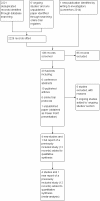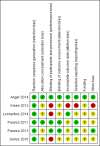Robot-assisted surgery in gynaecology
- PMID: 25493418
- PMCID: PMC6457792
- DOI: 10.1002/14651858.CD011422
Robot-assisted surgery in gynaecology
Update in
-
Robot-assisted surgery in gynaecology.Cochrane Database Syst Rev. 2019 Apr 15;4(4):CD011422. doi: 10.1002/14651858.CD011422.pub2. Cochrane Database Syst Rev. 2019. PMID: 30985921 Free PMC article.
Abstract
Background: This is an updated merged review of two originally separate Cochrane reviews: one on robot-assisted surgery (RAS) for benign gynaecological disease, the other on RAS for gynaecological cancer. RAS is a relatively new innovation in laparoscopic surgery that enables the surgeon to conduct the operation from a computer console, situated away from the surgical table. RAS is already widely used in the United States for hysterectomy and has been shown to be feasible for other gynaecological procedures. However, the clinical effectiveness and safety of RAS compared with conventional laparoscopic surgery (CLS) have not been clearly established and require independent review.
Objectives: To assess the effectiveness and safety of RAS in the treatment of women with benign and malignant gynaecological disease.
Search methods: For this update, we searched the Cochrane Central Register of Controlled Trials (CENTRAL) (2014, Issue 5) and the Cochrane Gynaecological Cancer Review Group Trials Register. We also searched MEDLINE and EMBASE databases, to complement the searches of the original malignant and benign disease reviews (conducted up to July 2010 and November 2011, respectively), from July 2010 to June 2014.
Selection criteria: Randomised controlled trials (RCTs) of RAS compared with CLS or open surgery in women requiring surgery for gynaecological disease.
Data collection and analysis: Two review authors independently assessed the studies for inclusion and risk of bias, and extracted study data and entered them into an Excel spreadsheet. We subgrouped data according to type of procedure and pooled data using random-effects methods in RevMan 5.3. We performed sensitivity analyses by excluding studies at high risk of bias.
Main results: We included six RCTs involving 517 women. Most were at low to moderate overall risk of bias; one was at high risk of bias. Four studies evaluated RAS for hysterectomy (371 women), and two studies evaluated RAS for sacrocolpopexy (146 women). All studies compared RAS with CLS, except for one study, which compared RAS with CLS or a vaginal surgical approach for hysterectomy. Confidence intervals for the risk of intraoperative and postoperative complications included benefits with either approach when they were analysed together (risk ratio (RR) 0.95, 95% confidence interval (CI) 0.46 to 1.99; participants = 513; studies = 6; I(2) = 74%) and separately (low-quality evidence). Moderate-quality evidence was found for the effects of RAS on intraoperative injury when compared with CLS (RR 1.23, 95% CI 0.44 to 3.46; participants = 415; studies = 5; I(2) = 0%), along with low-quality evidence for bleeding and infection complications.Mean total operating time was consistent across procedures and on average was about 42 minutes longer in the RAS arm compared with the CLS arm (95% CI 17 to 66 minutes; participants = 294; studies = 4; I(2) = 82%; moderate-quality evidence). Mean hospital stay for hysterectomy procedures was on average about seven hours shorter in the RAS arm than in the CLS arm (mean difference (MD) -0.30 days, 95% CI -0.54 to -0.06; participants = 217; studies = 2; I(2) = 0%; low-quality evidence). The estimated effect of conversion with RAS compared with CLS was imprecise (RR 1.28, 95% CI 0.40 to 4.12; participants = 337; studies = 4; I(2) = 0%; moderate-quality evidence). Limited data from two studies suggest that RAS for sacrocolpopexy may be associated with increased postoperative pain compared with CLS; this needs further investigation. We identified five ongoing trials-four of cancer surgery.
Authors' conclusions: We are uncertain as to whether RAS or CLS has lower intraoperative and postoperative complication rates because of the imprecision of the effect and inconsistency among studies when they are used for hysterectomy and sacrocolpopexy. Moderate-quality evidence suggests that these procedures take longer with RAS but may be associated with a shorter hospital stay following hysterectomy. We found limited evidence on the effectiveness and safety of RAS compared with CLS or open surgery for surgical procedures performed for gynaecological cancer; therefore its use should be limited to clinical trials. Ongoing trials are likely to have an important impact on evidence related to the use of RAS in gynaecology.
Conflict of interest statement
The review authors have reported no known conflicts of interest.
Figures
























References
References to studies included in this review
-
- Anger J, Mueller E, Tarnay C, Brubaker L, Rosenman A, Smith B. Abdominal colpopexy: comparison of endoscopic surgical strategies. Journal of Urology. 2012 Annual Meeting of the American Urological Association, AUA Atlanta, GA United States. Conference Start: 20120519 Conference End: 20120523. Conference Publication:(var.pagings). 2012:e864.
- Anger JT, Mueller ER, Tarnay C, Smith B, Stroupe K, Rosenman A, et al. Robotic compared with laparoscopic sacrocolpopexy: a randomized controlled trial. Obstetrics and Gynecology 2014;123(1):5‐12. - PMC - PubMed
- Kenton K, Mueller E, Tarnay C, Brubaker L, Rosenman A, Smith B, et al. Comparative effectiveness of robotic and laparoscopic sacrocolpopexy for apical vaginal prolapse: one year outcomes. Journal of Urology Conference: 2013 Annual Meeting of the American Urological Association, AUA San Diego, CA United States. Conference Start: 20130504 Conference End: 20130508. Conference Publication:(var.pagings). 2013:e877‐8.
- Mueller ER, Kenton K, Tarnay C, Brubaker L, Rosenman A, Smith B, et al. Abdominal colpopexy: comparison of endoscopic surgical strategies (ACCESS). Contemporary Clinical Trials 2012;33(5):1011‐8. - PMC - PubMed
- Tarnay C, Kenton K, Anger J, Bresee C, Brubaker L, Rosenman A, et al. Trocar site appearance one year after robotic vs. Laparoscopic sacrocolpopexy. Neurourology and Urodynamics Conference: Society for Urodynamics and Female Urology 2013 Winter Meeting Las Vegas, NV United States. Conference Start: 20130226 Conference End: 20130302. Conference Publication:(var.pagings). 2013:159.
-
- Green JL, Deimling T, Tam T, Davies MF, Harkins GJ. A randomized controlled trial comparing conventional laparoscopic hysterectomy with robot‐assisted laparoscopic hysterectomy in a teaching institution. Journal of Minimally Invasive Gynecology Conference: 42nd Global Congress of Minimally Invasive Gynecology, AAGL 2013 Washington, DC United States. Conference Start: 20131110 Conference End: 20131114. Conference Publication:(var.pagings). 2013:S4.
- Harkins G. Study of conventional laparoscopic hysterectomy versus robot‐assisted laparoscopic hysterectomy at a teaching institution. Clinicaltrials.gov2012; Vol. http://clinicaltrials.gov/ct2/show/NCT01581905?term=NCT01581905&rank=1, issue accessed 4 July 2014.
-
- Lonnerfors C, Reynisson P, Persson J. A randomized trial comparing vaginal‐ and laparoscopic hysterectomy to robot‐assisted hysterectomy. Journal of Minimally Invasive Gynecology 2014;Jul 18:doi: 10.1016/j.jmig.2014.07.010. [Epub ahead of print]. - PubMed
- Persson J. Robotic hysterectomy versus vaginal hysterectomy or traditional laparoscopic hysterectomy [NCT01865929]. Clinicaltrials.gov2013.
-
- Frick AC, Barber MD, Jelovsek JE, Fu Z, Chen G, Paraiso MR. Cost analysis of laparoscopic versus robotic sacrocolpopexy in a randomized controlled trial. Journal of Pelvic Medicine and Surgery 2011;17 Suppl 1(2):17. [37th Annual Scientific Meeting of the Society of Gynecologic Surgeons, SGS 2011 San Antonio, TX United States]
- Paraiso M, Chen C, Jelovsek JE, Frick A, Barber MD. Conventional laparoscopic versus robotic‐assisted laparoscopic sacral colpopexy: a randomized controlled trial. Journal of Pelvic Medicine and Surgery 2010;16 Suppl 2(5):58‐9. [31st Annual Scientific Meeting of the American Urogynecologic Society, AUGS Long Beach, CA United States]
- Paraiso MF, Chen CC, Jelovsek JE, Frick A, Barber MD. Conventional laparoscopic versus robotic‐assisted laparoscopic sacral colpopexy: a randomized controlled trial. Journal of Minimally Invasive Gynecology 2010;17 Suppl 1(6):25. [39th Global Congress of Minimally Invasive Gynecology, AAGL 2010 Las Vegas, NV United States]
- Paraiso MF, Jelovsek JE, Frick A, Chen CC, Barber MD. Laparoscopic compared with robotic sacrocolpopexy for vaginal prolapse: a randomized controlled trial. Obstetrics and Gynecology 2011;118(5):1005‐13. - PubMed
- Paraiso MF, Jelovsek JE, Frick A, Chen CCG, Barber MD. Laparoscopic versus robotic‐assisted laparoscopic sacral colpopexy: a randomized controlled trial. Neurourology and Urodynamics 2010;29(6):964‐5. [Joint Annual Meeting of the International Continence Society, ICS and International Urogynecological Association, IUGA Toronto, ON Canada]
-
- Paraiso MF, Ridgeway B, Park AJ, Jelovsek JE, Barber MD, Falcone T, et al. A randomized trial comparing conventional and robotically assisted total laparoscopic hysterectomy. American Journal of Obstetrics and Gynecology 2013;208(5):368.e361‐368.e367. - PubMed
References to studies excluded from this review
-
- Advincula AP, Xiao Xu, Goudeau S, Ransom SB. Robot‐assisted laparoscopic myomectomy versus abdominal myomectomy: a comparison of short‐term surgical outcomes and immediate costs. Journal of Minimally Invasive Gynecology 2007;14(6):698‐705. - PubMed
-
- Bell MC, Torgerson J, Seshadri‐Kreaden U, Suttle AW, Hunt S. Comparison of outcomes and cost for endometrial cancer staging via traditional laparotomy, standard laparoscopy and robotic techniques. Gynecologic Oncology 2008;111(3):407‐11. - PubMed
-
- Boggess JF, Gehrig PA, Cantrell L, Shafer A, Ridgway M, Skinner EN, et al. A case‐control study of robot‐assisted type III radical hysterectomy with pelvic lymph node dissection compared with open radical hysterectomy. American Journal of Obstetrics and Gynecology 2008;199(4):357.e1‐7. - PubMed
-
- Boggess JF, Gehrig PA, Cantrell L, Shafer A, Ridgway M, Skinner EN, et al. A comparative study of 3 surgical methods for hysterectomy with staging for endometrial cancer: robotic assistance, laparoscopy, laparotomy. American Journal of Obstetrics and Gynecology 2008;199(4):360.e1‐9. - PubMed
References to ongoing studies
-
- Kjölhede P. RCT comparing robot assisted laparoscopic hysterectomy to abdominal hysterectomy in endometrial cancer [NCT01526655]. Clinicaltrials.gov2012.
-
- Soto E. Laparoscopy vs. robotic surgery for endometriosis (LAROSE): a prospective randomized controlled trial [NCT01556204]. Clinicaltrials.gov2012. - PubMed
-
- Narducci F. Perioperative morbidity in gyneco‐oncology according to the procedure: coelioscopy vs robot‐assisted coelioscopy [NCT01247779]. Clinicaltrials.gov2010.
-
- Obermair A, Gebski V, Frumovitz M, Soliman PT, Schmeler KM, Levenback C. A phase III randomized clinical trial comparing laparoscopic or robotic radical hysterectomy with abdominal radical hysterectomy in patients with early stage cervical cancer [NCT00614211]. Journal of Minimally Invasive Gynecology 2008;15(5):584‐8. - PubMed
-
- Falconer H. Robotic versus abdominal surgery for endometrial cancer (RASHEC) [NCT01847703]. Clinicaltrials.gov2013.
Additional references
-
- Advincula AP, Song A, Burke W, Reynolds RK. Preliminary experience with robot‐assisted laparoscopic myomectomy. The Journal of the American Association of Gynecologic Laparoscopists 2004;11:511‐8. - PubMed
-
- Bell MC, Torgerson JL, Kreaden U. The first 100 da Vinci hysterectomies:an analysis of the learning curve for a single surgeon. S D Med 2009;62(91):93‐5. - PubMed
-
- Cadiere GB, Himpens J, Germay O, Izizaw R, Degueldre M, Vandromme J, et al. Feasibility of robotic laparoscopic surgery: 146 cases. World Journal of Surgery 2001;25:1467‐77. - PubMed
-
- Cela V, Freschi L, Simi G, Tana R, Russo N, Artini PG, et al. Fertility and endocrine outcome after robot‐assisted laparoscopic myomectomy (RALM). Gynecological Endocrinology 2013;29(1):79‐82. - PubMed
-
- Cho JE, Nezhat FR. Robotics and gynecologic oncology: review of the literature. Journal of Minimally Invasive Gynecology 2009;16(6):669‐81. - PubMed
References to other published versions of this review
Publication types
MeSH terms
LinkOut - more resources
Full Text Sources
Other Literature Sources

